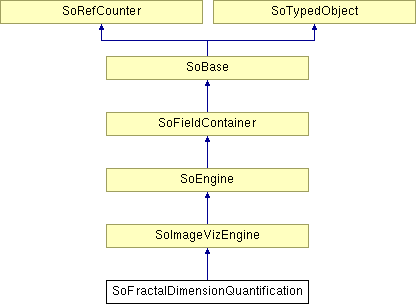SoFractalDimensionQuantification Class Reference
[Morphometry]
 SoFractalDimensionQuantification engine
More...
SoFractalDimensionQuantification engine
More...
#include <ImageViz/Engines/ImageAnalysis/Morphometry/SoFractalDimensionQuantification.h>

Classes | |
| class | SbFractalDetail |
| Results details of fractal dimension. More... | |
Public Member Functions | |
| SoFractalDimensionQuantification () | |
Public Attributes | |
| SoSFEnum | computeMode |
| SoSFImageDataAdapter | inBinaryImage |
| SoSFBool | useOnlyBorders |
| SoImageVizEngineAnalysisOutput < SbFractalDetail > | outResult |
Detailed Description
 SoFractalDimensionQuantification engine
SoFractalDimensionQuantification engine
The SoFractalDimensionQuantification engine measures fractal dimension.
For an introduction, see:
- section Analysis
- section Morphometry
This engine computes the fractal dimension of a binary 2D or 3D image. It should be used only if the feature is known as being potentially a fractal one. This is the case of complex and irregular curves which cannot be easily described with traditional geometric tools, and/or for curves which are very similar to a part of themselves at different scales.
2D definition:
The 2D fractal dimension is a number greater than 1 and strictly lower than 2. The result is 1 in case of standard geometric features (straight lines, broken lines, circles, ...). Applied to 2D images the fractal dimension is quite an effective indicator to measure and compare the irregularity and the fragmentation at different magnifications. It is also a good indicator to evaluate how the curve fills the space. The less smooth the curve is, the bigger the fractal dimension.
Caution: Do not use this engine on surfaces but on contours, according to the fractal definition. To be able to compare results, the outlines thickness should be very similar between the studied images and as small as possible so as to keep as much information as possible.
3D definition:
The 3D fractal dimension is a number greater than 2 and strictly lower than 3. The result is 2 in case of standard geometric surfaces (cubes, planes, ellipsoids, ...). Applied to 3D images the fractal dimension is quite an effective indicator to measure and compare the roughness of a surface. It is also a good indicator to evaluate how the curve fills the space. The less smooth the surface is, the bigger the fractal dimension. It can also be interpreted as a quantification of how complex the surface is and how it fills the space.
Caution: Do not use this engine on volumes but on surfaces, according to the fractal definition. To be able to compare results, the surface thickness should be very similar between the studied images and as small as possible so as to keep as much information as possible.
SEE ALSO
SoStructureModelIndexQuantification3d.
FILE FORMAT/DEFAULT
- FractalDimensionQuantification {
| computeMode | MODE_AUTO |
| inBinaryImage | NULL |
| useOnlyBorders | TRUE |
Library references: fractal
Constructor & Destructor Documentation
| SoFractalDimensionQuantification::SoFractalDimensionQuantification | ( | ) |
Constructor.
Member Data Documentation
Select the compute Mode (2D or 3D or AUTO) Use enum ComputeMode.
Default is MODE_AUTO
The input binary image.
Default value is NULL. Supported types include: binary color image.
The output measure result.
Default value is NULL.
Select if use only the object borders to compute measure.
Default value is TRUE.
The documentation for this class was generated from the following file:
- ImageViz/Engines/ImageAnalysis/Morphometry/SoFractalDimensionQuantification.h